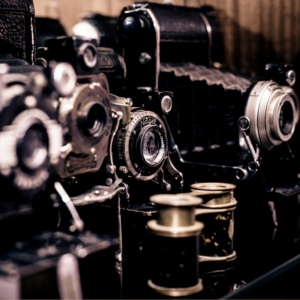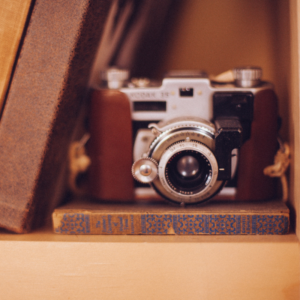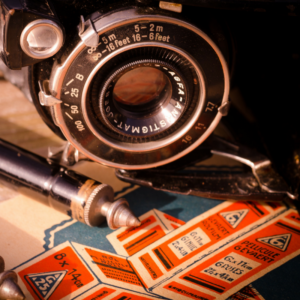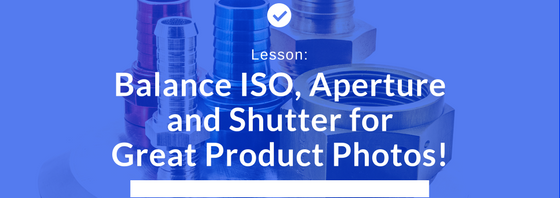Balance ISO, Aperture and Shutter for Great Product Photos!
A great camera can make a great photo, but there's no guarantee. A great photographer who knows the camera and how to execute the proper ISO, aperture and shutter techniques is the other side of the equation. Sure, a great camera is important, and it's always important to have the right tools for the job, but that won't help if you don't know what you're doing. This is one of the reasons you get consistently superior results when hiring a professional. 
First and foremost, they need to know good composition and lighting, those will always make a bigger difference than the camera will. But knowing how to use the tools at their disposal in order to apply their knowledge of the art of photography is equally essential. At Miceli Productions we’re able to do this because we know our camera gear inside and out.
What's there to know about a camera? Well, for starters there's ISO, aperture and shutter.
ISO
ISO is equivalent to the measure of the gain of the image. It doesn't change anything mechanically, it just adjusts the range of sensitivity of the image up or down. ISO works specifically with a camera's dynamic range.
Dynamic range is the how much your camera can see from shadows to highlights. The larger the ratio of shadows and highlights, the more difficult it is to keep detail in both. Photographers measure the dynamic range in f-stops. Most cameras have a dynamic range of 5-6 f-stops. Really good cameras can get up to 13 stops, but even they are no match for the human eye at roughly 22 stops. This means if you are looking at something with a huge range of light levels from dark to light, it might look fine to you but it won't to your camera. Once you snap a photo either you've blown out the highlights or the shadows are an impenetrable inky black (or both).
 Your ISO is the decision you make in situations like that stated above about where you want to keep detail. Do you want to see the highlights and push your mid-tones into the lower end of the blacks?Or do you want to see your shadows and push your mid-tones closer to pure white? The best answer is, of course, limit the ratio of highlights to shadows so your camera can capture everything. Limit what you take photos of based on the dynamic range you can capture. Keep important elements of the frame within the same limited range of light even if other parts of the frame end up blown out or too dark.
Your ISO is the decision you make in situations like that stated above about where you want to keep detail. Do you want to see the highlights and push your mid-tones into the lower end of the blacks?Or do you want to see your shadows and push your mid-tones closer to pure white? The best answer is, of course, limit the ratio of highlights to shadows so your camera can capture everything. Limit what you take photos of based on the dynamic range you can capture. Keep important elements of the frame within the same limited range of light even if other parts of the frame end up blown out or too dark.
Shutter Speed
The Shutter speed is how long the camera opens up the sensor to light. This influences a number of elements of your image so it's important that you are aware of how it works. Shutter speed can affect how blurry moving shots or fast-moving subjects are. Shutter speed also influences the exposure level of your image but in a different way than ISO.
Blurry photos are a drag (in most cases) so you want to avoid them. Whenever you snap a photo, the shutter opens and lets light hit the sensor. However long the shutter is open, the sensor is processing the reality in front of the lens. This means if someone jumps in front of your camera and the shutter is open for an entire second than the person will look like a colorful smear from the ground to the maximum height they jumped to. If the shutter is open instead for, say 1/500th of a second, the person in the photo will appear perfectly airborne and sharp. This applies to how steady you hold the camera as well. If the camera is shaking and you have a long exposure, the entire world can feel blurred and smeary.
There is another side to shutter speed and that is how much light you've let in. The more light you let in, the "brighter" your image will be. So if the shutter is open for only a tiny fraction of a second, your jumping friend will end up suspended crisply in the air, but they could end up very dark. There is a delicate balance you must walk with shutter and available light. This is why advanced photographers often takes advantage of powerful 500w or 1000w (all the way up to 20,000w) artificial lights. (Your typical household bulb is 40w-100w.) With powerful lights, there's enough light coming in for the short time the shutter is open that the image will look properly exposed.
Aperture
Also measured in f-stops, the aperture is the third and final tier of the exposure triangle. The aperture is an iris built into the lens. The iris is either contracted or expanded (much like a human eye) to let in less or more light. This may feel redundant to shutter or ISO, but it has very different consequences. The more you open your aperture, the shallower the depth of field becomes. Lenses also perform differently at different aperture settings.
The depth of field is a measure of what slice of depth in front of the camera is reasonably in focus. With longer lenses (telephoto and zoom lenses) the same aperture rating will have much shallower depth of field. Also, the object's size changes the depth of field inversely. Photographing a mountain will likely result in the entire subject being in focus. If you try to photograph a single ant, you will find the depth of field becomes razor-thin slices of focus. The shallower the depth of field, the more difficult it is to keep a moving subject in focus. If the night is fast approaching and you keep opening up the iris to let in more light, you may find it harder and harder to photograph the same subject and nail the focus.
 It's also important to know that manufacturers design lenses to operate best at certain settings (much like your camera). If you have a 50mm prime lens (very common in portrait and product photography) that has a maximum aperture of f/1.2, you might be tempted to work at f/1.2 because you love the blurry background and the ability to use only available light. However, that lens probably functions the best at f/4.0. Functioning best means the lens renders detail well and produces a sharp image with true colors. Whenever you adjust the aperture, you sacrifice a little detail, sharpness, and color.
It's also important to know that manufacturers design lenses to operate best at certain settings (much like your camera). If you have a 50mm prime lens (very common in portrait and product photography) that has a maximum aperture of f/1.2, you might be tempted to work at f/1.2 because you love the blurry background and the ability to use only available light. However, that lens probably functions the best at f/4.0. Functioning best means the lens renders detail well and produces a sharp image with true colors. Whenever you adjust the aperture, you sacrifice a little detail, sharpness, and color.
Professional product photographers must keep these three elements in balance when framing up a shot. Without the right care and respect to each of these essential tools, the image could come out grainy, dark, overexposed, or blurry (or all of the above). ISO, aperture and shutter. We execute these photography techniques everyday to get great shots. And clients that know how we create images can be the best at communicating what images they want for their products.

